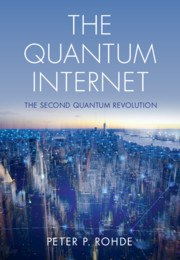Description
The Quantum Internet
The Second Quantum Revolution
Author: Rohde Peter P.
Language: English
Subject for The Quantum Internet:
Publication date: 09-2021
300 p. · 17.5x25 cm · Hardback
300 p. · 17.5x25 cm · Hardback
Description
/li>Contents
/li>Biography
/li>
Following the emergence of quantum computing, the subsequent quantum revolution will be that of interconnecting individual quantum computers at the global level. In the same way that classical computers only realised their full potential with the emergence of the internet, a fully-realised quantum internet is the next stage of evolution for quantum computation. This cutting-edge book examines in detail how the quantum internet would evolve in practise, focusing not only on the technology itself, but also the implications it will have economically and politically, with numerous non-technical sections throughout the text providing broader context to the discussion. The book begins with a description of classical networks before introducing the key concepts behind quantum networks, such as quantum internet protocols, quantum cryptography, and cloud quantum computing. Written in an engaging style and accessible to graduate students in physics, engineering, computer science and mathematics.
Part I. Introduction: 1. Foreword; 2. Introduction. Part II. Classical Networks: 3. Mathematical representation of networks; 4. Network topologies; 5. Network algorithms. Part III. Quantum Networks: 6. Quantum channels; 7. Optical encoding of quantum information; 8. Errors in quantum networks; 9. Quantum cost vector analysis; 10. Routing strategies; 11. Interconnecting and interfacing quantum networks; 12. Optical routers; 13. Optical stability in quantum networks. Part IV. Protocols for the Quantum Internet: 14. State preparation; 15. Measurement; 16. Evolution; 17. High-level protocols. Part V. Entanglement Distribution: 18. Entanglement – The ultimate quantum resource; 19. Quantum repeater networks; 20. The irrelevance of latency; 21. The quantum Sneakernet™. Part VI. Quantum Cryptography: 22. What is security?; 23. Classical cryptography; 24. Attacks on classical cryptography; 25. Bitcoin and the blockchain; 26. Quantum cryptography; 27. Attacks on quantum cryptography. Part VII. Quantum Computing: 28. Models for quantum computation; 29. Quantum algorithms. Part VIII. Cloud Quantum Computing: 30. The Quantum Cloud™; 31. Encrypted cloud quantum computation. Part IX. Economics and Politics: 32. Classical-equivalent computational power and computational scaling functions; 33. Per-qubit computational power; 34. Time-sharing; 35. Economic model assumptions; 36. Network power; 37. Network value; 38. Rate of return; 39. Market competitiveness; 40. Cost of computation; 41. Arbitrage-free time-sharing model; 42. Problem size scaling functions; 43. Quantum computational leverage; 44. Static computational return; 45. Forward contract pricing model; 46. Political leverage; 47. Economic properties of the qubit marketplace; 48. Economic implications; 49. Game theory of the qubit marketplace. Part X. Essays: 50. The era of quantum supremacy; 51. The global virtual quantum computer; 52. The economics of the quantum internet; 53. Security implications of the global quantum internet; 54. Geostrategic quantum politics; 55. The quantum ecosystem. Part XI. The End: 56. Conclusion. References. Index.
Peter P. Rohde is an ARC Future Fellow & Senior Lecturer in the Centre for Quantum Software & Information at the University of Technology, Sydney. His theoretical proposals have inspired several world-leading experimental efforts in optical quantum information processing.
© 2024 LAVOISIER S.A.S.




